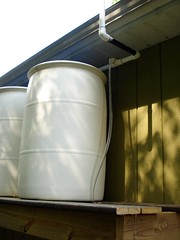| Rainwater harvesting systems channel rainwater from a roof into a storage tank via an arrangement of gutters and pipes. (Photo credit: Wikipedia) |
#2.) Tap your rain barrel with two flows. One flow will be there to release overflow in the event it rains so hard that your barrel fills up. The other flow can be used to utilize the water. You can attach a hose to it and direct water into your garden, or simply have a faucet you can turn off and on to fill your watering can as needed. You can purchase these simple faucets and overflow attachments at your local hardware or home store.
#3.) Protect your rain gutters. Placing covers over your rain gutters prevents the debris on your roof from entering your rain barrel. This debris can rot and contaminate the water. And it can clog the outputs in your rain barrel, making using the water difficult to draw out of the barrel. Rain gutter guards and shields can be purchased at your local hardware or home store and range in price from a few dollars to a high-priced and comprehensive gutter system.
| Rain Barrel System (Photo credit: Chiot's Run) |
#5.) Finally, make sure you’re allowed to harvest rainwater. It may sound silly but in some areas with water rights restrictions, you’re not allowed to harvest rainwater and can be fined (which in my opinion is pretty ridiculous, but if you live in a drought-prone area you may want to check).
Harvesting rainwater is an excellent way to maximize available water for your garden - and it also saves you money on your water bill!


Yeah, living in an area where there is frequent drought can discourage people who want to grow their own gardens. That is why, building a rainwater harvesting system for your home is a great idea, if you want to tend your lawn and take care of your plants without hurting your pockets. A rainwater harvesting system will help you save money on your water bills and help you conserve water.
ReplyDelete